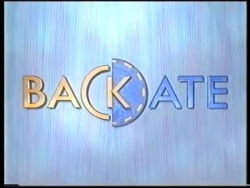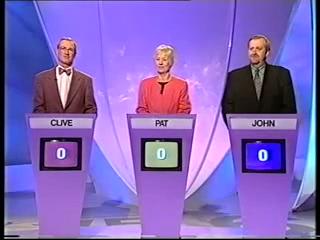Backdate
(→Trivia: that is not the correct use of that word) |
|||
| Line 46: | Line 46: | ||
== Trivia == | == Trivia == | ||
| - | Originally aired in the | + | Originally aired in the 4pm slot just before [[Countdown]] and [[Fifteen-to-One]], but was moved to 12:30pm for the last few episodes when Channel 4 decided to permanently put Fifteen-to-One in the 4pm slot. |
== See also == | == See also == | ||
Revision as of 17:17, 16 April 2020
Contents |
Host
Valerie Singleton
Broadcast
Action Time for Channel 4, 1 January to 25 October 1996 (135 episodes in 2 series)
Synopsis
Veteran children's TV presenter Singleton quizzes three contestants on a range of history questions. The three rounds are basically variations on a theme. Correct answers allow contestants to take a number between 1 and 95 from a board, three such numbers of a valid format (e.g. 2/11/89) creating a "dateline".
It starts with a flashy opening sequence backed by a tuneful opening theme (although their choice of instrumentation was suspect - they use what sounds like a late '70s electronic organ's attempt at a piano, and it sounds cheap) leading up to the show starting in the traditional Action Time studio. All Action Time shows (made in their own studios) look very similar - game-board, if there is one, in the background, host sat at the left, contestants behind podiums at the right. Lots of their shows have been based on exactly the same studio layout. (Clive Doig's shows are a mirror-image of that, though - contestants at the left, host at the right. Is Leahy right-handed and Doig left-handed, perchance? Hmm.)
After a very swift introduction (and the contestants reveal their birthdates and say who else was born on that day, a nice touch) we go straight into the first round. The premise of the show is that by correctly answering questions contestants win numbers chosen from the masterboard (a video wall of 3 forty-inch-plus screens, 27 numbers on the screens, 9 from 1 to 12, another 9 from 13 to 31 and 9 from 46 to 95) for themselves and can place the number in their grid. There was a slight change for episodes shown in the autumn, where the master board was split into nine "days", nine "months", and nine "years". Players had to put "month" numbers in the "month" column, they couldn't be used as a "day".
Each player's grid consists of three lines; each line has a space for a day, a month and a year. Once a line is complete with a day in the day space, a month in the month space and a year in the year space, the line is complete and a dateline is formed. A question is asked pertaining to that date (and they do have a question for each of the 18,000+ possible D/M/Y combinations taken from newspapers of the day, earlier dates having less obscure questions attached - this must have involved thousands of questions being made for the programme) and correct answer to that dateline question is worth a bonus. All questions are worth 10 points, all dateline questions worth 30. Once a dateline question has been asked, the dateline is used up; if the question was asked incorrectly, the player must replace one of the numbers in it to create a new dateline for a new question; if the question was answered correctly, the dateline is frozen, and another dateline must be formed from 3 other numbers. Actually, the dateline theme is the best bit of the show. Once a dateline is formed, the numbers forming it light up and are displayed in BIG writing, one per video screen. It looks very good. Nice graphic effect, although very simple.
 Valerie Singleton in front of the game board (today featuring the face of John Lennon).
Valerie Singleton in front of the game board (today featuring the face of John Lennon).Round one has nine questions on general knowledge, designed to get some numbers into the player's grids. Each question gets the player a number chosen at random. It's done at a cracking pace and by the end of round one you think that Action Time have finally cracked it; the first six minutes or so of the show are very good. Round two lets the whole thing right down, though. Three questions to each player, the first on films and television, the second on music and the third on quotes. However, each question takes about 30 or 40 seconds because they use a very long clip before each one. You just lose interest in the game altogether at this point. A question from Valerie for the viewers at home takes us into the break.
From the break, the answer to the question and then round three, "Pick or Pinch". Rather like round one, but each correct answer earns the contestant either a number from the masterboard or from another player's grid. What can happen is a player fills two datelines up, then in filling the second he freezes it and unfreezes the first. One more question changes the first dateline and unfreezes the second, and so on. It's easy for a good player to run away with it, getting many datelines correct. A fanfare signals the end of the game and the two losing contestants get electronic personal organisers which look quite cheap - about forty pounds in value at most.
The winner goes on to play the end-game, A Date With A Decade. A decade is then picked ('50s, '60s, '70s, '80s or "'90s" - '86 to '95) and nine years from that decade appear on a video wall in a 3x square. Then nine events are read out in succession and the player must match the events to the years. The contestant has 60 seconds to do this - any he gets wrong the first time are returned-to after the first attempt. The game can be trivially won by a player with sufficient gall to go "80-80-80-80-80-80-80-80-80- 81-81-81-81-81-81-81-81-82-82" and so on, but it won't happen. As each event is matched to a year, the year disappears and a part of a face (broken up into a 3x3 grid and jumbled) appears. If all nine events are matched within 60 seconds, the player gets 5 more seconds to look at the jumbled-up face and recognise which personality from the decade chosen it is. If they can, then they win a leather-bound Chronicle of the Twentieth Century (nice, but hardly valuable); if not, the same electronic personal organiser.
Valerie, in her first and thus far only game show hosting role, is workwomanlike and composed, but very slow indeed during the second round and more monotonous than you would like. The show itself is of safe and less than controversial format, though the game is quite well designed (however, freezing a dateline out of the game completely once used and playing until one player fills their grid up with three finished-and- correctly-answered datelines might have been more interesting). The show looks cheap but reasonably tasteful. And the theme tune is quite nice. But a novel twist and a stern, rather humourless presenter do not make a good format alone, and the show fizzled out after two series.
Inventor
Created by Trish Kinane and Mike Adams.
Theme music
Paul Boross and Henry Marsh
Trivia
Originally aired in the 4pm slot just before Countdown and Fifteen-to-One, but was moved to 12:30pm for the last few episodes when Channel 4 decided to permanently put Fifteen-to-One in the 4pm slot.
See also
Today's the Day, a more successful nostalgia quiz of the same era.
Weaver's Week review, comparing Backdate to Today's the Day.
Videos
An episode from Series 2.



